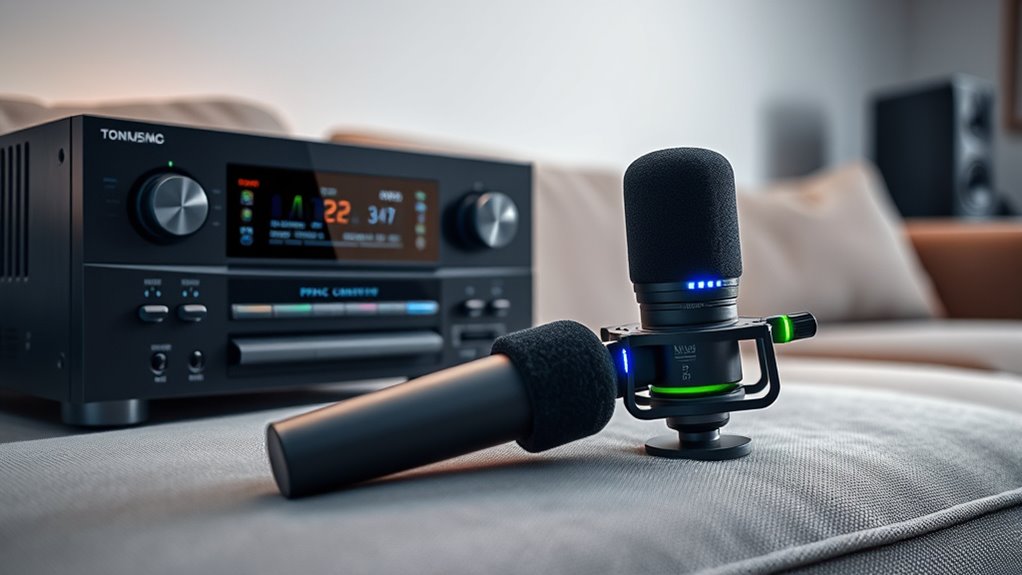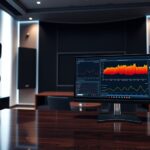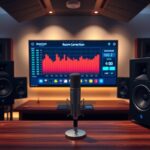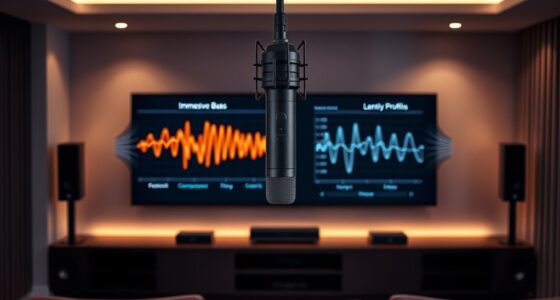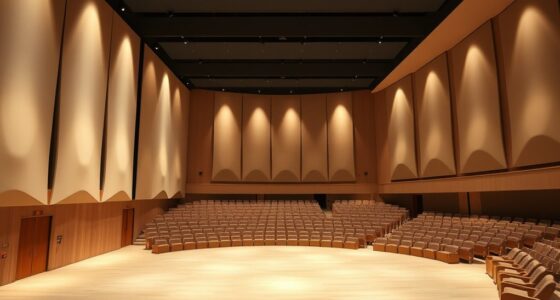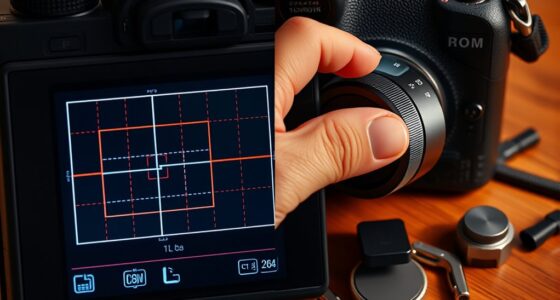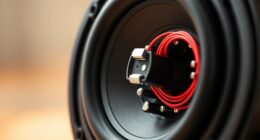Automatic room correction systems like Dirac, Audyssey, and YPAO analyze your room’s acoustics and make digital adjustments to improve sound quality. Dirac offers precise frequency and phase corrections, while Audyssey and YPAO provide user-friendly setups that also optimize speaker placement. However, manual adjustments allow you to fine-tune speaker positions and address specific acoustic issues for even better sound. To discover how combining both methods can optimize your system, keep exploring the options available.
Key Takeaways
- Dirac offers advanced, precise correction for frequency and phase, often outperforming Audyssey and YPAO.
- Audyssey provides user-friendly, effective calibration suitable for most setups, with less complexity.
- YPAO includes speaker placement optimization, including subwoofer positioning, aiding physical setup adjustments.
- Automatic systems improve sound quality but may require manual tweaks or room modifications for best results.
- Combining automatic calibration with manual adjustments or acoustic treatments yields optimal room correction outcomes.

When it comes to optimizing your audio experience, the choice between automatic and manual room correction can make a significant difference. Automatic systems like Dirac, Audyssey, and YPAO are designed to simplify the process, but they each have their strengths and weaknesses. Your room’s acoustics, including factors like woofer placement and acoustic treatment, play a pivotal role in how effective these systems are. If your speakers are poorly placed or your room lacks proper acoustic treatment, automatic correction might not fully compensate for those issues. Still, these systems can provide a quick, convenient way to improve sound quality without delving into complex calibration.
Automatic room correction works by analyzing your room’s acoustics through a microphone, then adjusting the audio output to minimize reflections, standing waves, and other acoustic anomalies. Systems like Dirac are known for their sophisticated algorithms that fine-tune frequency response and phase alignment, delivering a more accurate soundstage. Audyssey, on the other hand, offers user-friendly calibration that’s effective for most setups, especially when you’re starting out. YPAO, Yamaha’s system, is similarly effective and often includes features that help you optimize speaker placement, including considerations for woofer positioning. However, the effectiveness of these automatic corrections heavily depends on the initial setup. For example, if your woofer isn’t properly placed—say, too close to a corner or against a wall—automatic correction might only partially compensate, leading to muddiness or boominess. Acoustic treatment, like bass traps or diffusers, can also limit what these systems can fix. If your room absorbs or reflects sound poorly, you might need to physically modify the environment rather than rely solely on software adjustments. Additionally, the resolution of your system can influence how well these corrections work, especially in rooms with complex acoustics.
Manual room correction gives you the opportunity to fine-tune your setup beyond what automatic systems can do. You can experiment with woofer placement to reduce bass buildup or nulls, ensuring a more balanced response across the listening area. This approach allows you to address specific issues that automatic calibration might overlook, especially in rooms with challenging acoustics. Combining manual adjustments with initial automatic calibration often yields the best results, giving you control over critical aspects like speaker positioning, acoustic treatment, and EQ settings. While manual correction requires more effort and some technical know-how, it empowers you to tailor your audio environment precisely. Ultimately, understanding your room’s unique characteristics and making deliberate adjustments—whether through software or physical modifications—will provide the most satisfying listening experience.
Frequently Asked Questions
How Do Room Correction Systems Impact Overall Sound Quality?
Room correction systems substantially enhance your sound quality by optimizing speaker calibration, ensuring each speaker’s output aligns perfectly with your room’s acoustics. They automatically adjust for issues like reflections and standing waves, reducing the need for extensive acoustic treatment. This results in clearer dialogue, richer bass, and more balanced sound, making your listening experience more immersive without manual adjustments.
Can Manual Adjustments Outperform Automatic Room Correction?
Yes, manual adjustments can outperform automatic room correction if you have strong calibration skills and patience. By focusing on manual tuning, you can achieve precise calibration tailored to your room’s unique acoustics, often surpassing automatic systems’ capabilities. Automatic corrections rely on algorithms, but manual calibration allows you to fine-tune settings for ideal sound quality, giving you greater control over your listening experience.
Which System Is Best for Small Rooms Versus Large Rooms?
For small rooms, Audyssey or YPAO work well because they’re simple and quick, handling room size considerations effectively. In larger rooms, Dirac’s system scalability offers more precise tuning, making it preferable. You’ll find that choosing a correction system depends on your room size and how much you want to customize. Larger spaces benefit from Dirac’s advanced features, while smaller rooms do fine with more straightforward automatic options.
Are There Specific Genres of Music or Movies Better Suited for Each Correction Method?
You’ll find that each correction method enhances different genre preferences and movie styles. Dirac often excels with music genres like classical or jazz, providing clear, natural sound. Audyssey works well for dynamic movie styles, delivering balanced audio across scenes. YPAO is user-friendly, making it great for casual listening or standard movies. Choose based on your genre preferences and the type of movies you enjoy most for ideal sound quality.
How Does Room Correction Affect Speaker Lifespan and Performance?
Room correction mainly enhances your system calibration, leading to clearer sound and better performance. It doesn’t directly affect speaker durability, so your speakers won’t wear out faster. However, proper calibration helps prevent overdriving your speakers, which can prolong their lifespan. By maintaining ideal volume levels and avoiding distortion, you ensure your speakers stay in good shape longer, maximizing both their durability and your overall listening experience.
Conclusion
Choosing between automatic and manual room correction is like steering a vast, intricate forest—you can rely on a GPS to guide you quickly or explore your instincts to find hidden paths. Automatic systems like Dirac, Audyssey, and YPAO offer convenience, but manual adjustments give you precise control. Ultimately, it’s about finding the right balance between guidance and exploration, ensuring your sound environment becomes a harmonious symphony rather than a tangled thicket.
